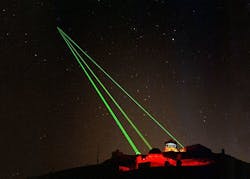Air Force to ask industry for 75-Watt sodium laser to create artificial stars for adaptive optics
Officials of the Officials of the Air Force Research Laboratory Directed Energy Directorate at Kirtland Air Force Base issued a notice last week (FA9451-19-9-0001_Presolicitation) for the Brighter Sodium Beacon project.
This project will ask industry to develop a sodium beacon laser more powerful than 75 Watts to generate artificial stars. Researchers will issue a formal solicitation for this project between now and the end of March, Air Force officials say.
The powerful sodium laser will project an image in the atmosphere that looks like a bright artificial star that is within the field of view of the Starfire Optical Range's main 3.5 meter telescope. This telescope will detect any change in the shape of the artificial star due to atmospheric turbulence. The telescope then compensates for any turbulence using adaptive optics.
Related: Adaptive optics blends the best of electronic and optoelectronic technologies
Disturbances in the Earth's atmosphere cause minor distortions in beams of light. This phenomenon causes what appears to the human eye to be the twinkling of stars at night. Ground-based astronomical observatories compensate for atmospheric turbulence with adaptive optics, which act like flexible mirrors to counteract the effects of atmospheric turbulence.
The make the right corrections, however, adaptive optics need a reliable very bright star to measure atmospheric turbulence. Most natural stars aren't bright enough for this job, or are not in the Starfire Optical Range's field of view. This is where sodium laser-projected artificial stars come in.
Adaptive optics use this kind of a guide star as a wavefront reference source of light. The sodium laser creates the artificial guide star by shining a laser into the atmosphere. Light from the beam reflects off components in the upper atmosphere back into the telescope.
Sodium lasers for this purpose are tuned to 589.2 nanometers to energize atoms in the sodium layer of the mesosphere at an altitude of around 56 miles above the Earth's surface. The sodium atoms then re-emit the laser light, producing a glowing artificial star.
Related: Boeing to help Air Force develop space superiority technologies for the control of space
The Air Force's Starfire Optical Range helps scientists perfect adaptive optics not only for astronomical observations, but also to sharpen the focus of powerful lasers for high-resolution satellite imaging, anti-satellite weapons, and relay mirror systems.
Last May the Air Force Research Lab issued a request for information on breakthrough research in sodium beacon lasers stronger than 50 Watts. Since then, planners have increased the desired laser's strength to more than 75 Watts.
Companies interested in this project can submit questions by email to the Air Force's Kimerie Smith at [email protected]. Copy email questions to the Air Force's Greg Davis at [email protected].
More information on the Brighter Sodium Beacon project is online at https://www.fbo.gov/spg/USAF/AFMC/AFRLPLDED/FA9451-19-9-0001_Presolicitation/listing.html.
Ready to make a purchase? Search the Military & Aerospace Electronics Buyer's Guide for companies, new products, press releases, and videos
